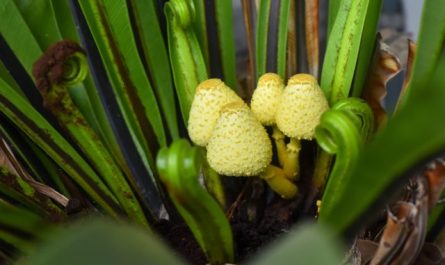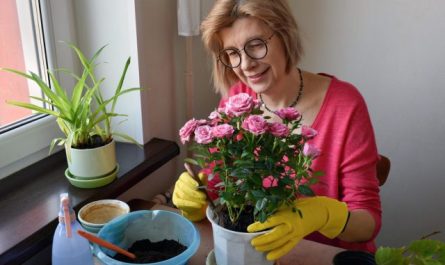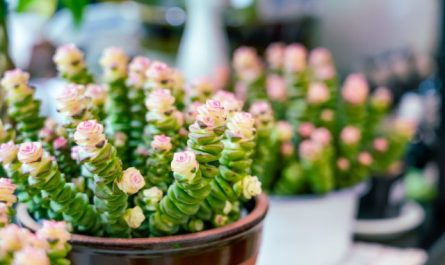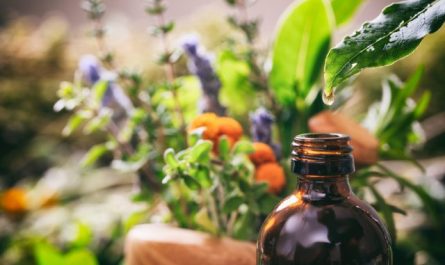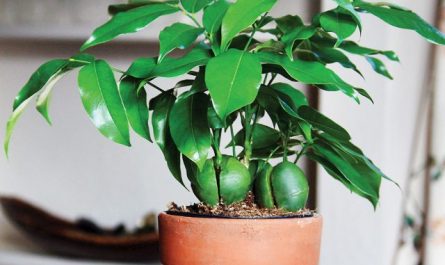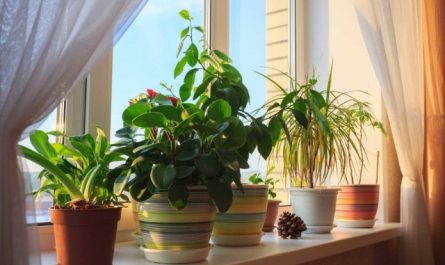There are about three thousand species of palm trees on Earth. The homeland of these trees is the tropics and subtropics, where they reach enormous sizes.
If for the inhabitants of tropical countries palm trees have long been an important source of existence, then in the northern regions these beautiful exotic plants are a magnificent decoration of greenhouses and interiors.
At the turn of the 19th and 20th centuries, palm trees were an essential attribute of living spaces and winter gardens, but then they lost their popularity. Nowadays, the decorative qualities of these plants are appreciated, and they are again leading in interior landscaping, bringing a touch of exoticism, reminding of distant countries and travels. And this tree is also associated with luxury. It is not for nothing that they say “to live under palm trees” – it means to lead a beautiful and comfortable existence, a real paradise life.

© flower bee
Fan fingers
Palms are woody plants, a family of palms or arecaceae. The lignified stem usually ends with pinnate or fan-shaped leaves up to 3 m long. There are bush-like and even dwarf palms. Flowers appear in the leaf axils and are collected in an inflorescence in the form of panicles. Leaf scars give the trunk of the plant a special decorative effect.
According to the shape of the leaves, there are pinnate-leaved and fan-leaved palms. Here are the most popular ones.
- Coconut palm (lat. Cocos nucifera). It has very sparse, long, paired leaves. As the plant develops, the lower branches die off, and new ones appear at the top of the main stem and eventually form a trunk. Coconut is a slow-growing palm tree and is usually bought as a curiosity. If you do not have large areas, buy Microcoelum – a miniature copy of the coconut palm.
- Date palm (lat. Phoenix). Large, feathery, glaucous-green leaves of the date palm are effectively arranged around a powerful trunk covered with the remains of leaf bases. The date palm is beautiful, elegant and you can easily grow it yourself..
- Howea (kentia) (lat. Howea). An elegant indoor palm with long, graceful leaves that grow very slowly. Usually one or two new leaves appear per year, so Three or four specimens are usually planted in a potWith good care, Howea can grow up to three meters.
- Trachycarpus (lat. Trachycarpus). One of the most cold-resistant palms. For example, in Sochi it grows in open ground. In room conditions, its trunk reaches three meters in height. The top is decorated with a bunch of fan-shaped leaves, and the stalk has thorns, the trunk of the palm is effectively covered with brown fibers, i.e. the remains of dead leaves.
- Chamaedorea (lat. Chamaedorea)If you don’t have a lot of space, but you want to have a palm tree, choose a chamedorea. This is an ideal tree for residential premises.: no more than a meter tall, unpretentious and blooms when very young. Its light yellow flowers are collected in a slightly drooping panicle and bloom regardless of the season. The fruits of the chamedorea are like small blue berries.
- Chrysalidocarpus (lat. Chrysalidocarpus). A very beautiful palm tree with abundantly branching at the base, yellowish stems, with graceful feathery green leaves. An exceptionally elegant palm tree.
- Chamaerops (lat. Chamaerops). Due to its slow growth and unpretentiousness in culture, chamaerops – one of the most popular indoor palmsWith its fan-shaped leaves it resembles a hedgehog.
- Rapis (lat. Rhapis). Perfection of form is one of the advantages of rapis. Thin graceful stems of the palm, forming thickets, resemble reeds. Therefore, the plant is sometimes called reed palm. Its leaves are much smaller than those of other types of palms, divided into 7-10 segments. The petioles of old leaves, remaining on the stems, create a unique fibrous covering. There are variegated varieties with yellow and green specks on the leaves. By the way, rapis is a plant that reacts to polluted air in the room..

© Forest & Kim Starr
False palms
Some indoor plants are called false palms because of their lignified leafless stems with a bunch of leaves at the top. These include such beautiful and majestic trees as dracaena, cordyline, yucca, pandanus. If you can’t grow a real one, get a pseudo palm tree in your home. In addition, they are often unpretentious in care. For example, the elephant-footed yucca will tolerate light shade, drafts, and underwatering. The only thing it does not like, like real palms, is overwatering. There are many different types of yucca – aloe-leaved, narrow-leaved, glaucous, fibrous (it is covered with large white, purple, bell-like flowers). Pandanus will also decorate your home. Their sharp, gracefully curved, spirally arranged leaves on the stem with cream, white or yellowish stripes along the edges resemble pineapple leaves. And the aerial stilt roots add exoticism. But if there are small children in the house, it is better to refuse this plant, because the thorns along the edge of the leaf can injure the child. And how many types of dracaena exist! They are quite undemanding to care for and so beautiful. For example, one of the most popular “Order Ribbon” with white-green leaves around the stem resembles sails on a mast. And the narrow leaves of the dracaena, bordered at the top of a thin tree-like stem, are exactly like a palm tree. Cordyline is like a sister to dracaena, it is not for nothing that they are often confused. Flower lovers choose cordyline for the bright red color of the upper leaves (it is not for nothing that it is also called the tree – Fire-breathing dragon). You just need to remember that the plant is not for beginners, it will suit those who have some experience in handling indoor flowers.

© Eric in SF
Ambulance for your aquarium
Palm trees are quite hardy plants.. But they also get sick. Here are the most common “palm problems”.
Brown leaf tips. The most probable cause is dry air (especially in heated rooms in winter), insufficient watering. It happens that the cause is cold air, because even from contact with cold glass in winter the palm can react in this way. But the most common cause is still insufficient humidity.
Brown spots on leaves. This is a signal of over-wetting of the soil, the use of very hard water for irrigation. It can also be a consequence of a sharp drop in temperature.
Yellowing foliage. Lack of wateringIn summer the soil should be constantly moist.
Young leaves are drying up. Too much sunlight, provide the plant with diffused light.
Lower leaves dry out. Many palms experience lower leaves that darken and die off as they age.They are removed with a sharp knife, cutting as close to the trunk as possible.
The plant is not developing. It is too cold and damp, there are not enough nutrients. Move the palm tree to a warmer place and let the soil dry out.In summer, “feed” the palm tree every two weeks.
Spray and water the plant regularly with soft, warm water. Trim the tips, trying to leave a thin, dry strip above the healthy tissue.
Protectable!
The pests that most bother palm trees are scale insects, spider mites, mealybugs, and thrips.

© flower bee
Shchitovka. Brown plaques on the surface of leaves and stems indicate that this harmful “beast” has settled on the tree. Scale insects suck out the cell juice and the leaves dry up and fall off.
spider mite. The appearance of this pest is facilitated by too dry (especially in winter) air in apartments. A web appears on the stems of the plant, the leaves wither and fall off.
Mealybug. If white larvae have appeared in the soil and white fibrous formations have appeared in the leaf axils, your favorite palm has been attacked by mealybug. If help is not provided in time, the plant may die.
TRIPSSilvery and black spots appear on the leaves.

© Forest & Kim Starr
This measure helps against all these pests. Wipe the plant with a soapy sponge and rinse with warm water. Then spray with a 0,15% solution of actellic (1-2 ml per liter of water). Carry out treatments until the pests disappear completely.. You can also spray the palms with a solution of malathion once every 2 weeks, trying to treat the leaf axils well (for mealybugs). You can follow the advice of your grandmothers and treat the plants, for example, from spider mites, with a daily infusion of onions or garlic in a liter of water with the addition of 5 g of soap.
Materials used:
- The house will be decorated with palm trees – “My favorite flowers” 11. 2009


